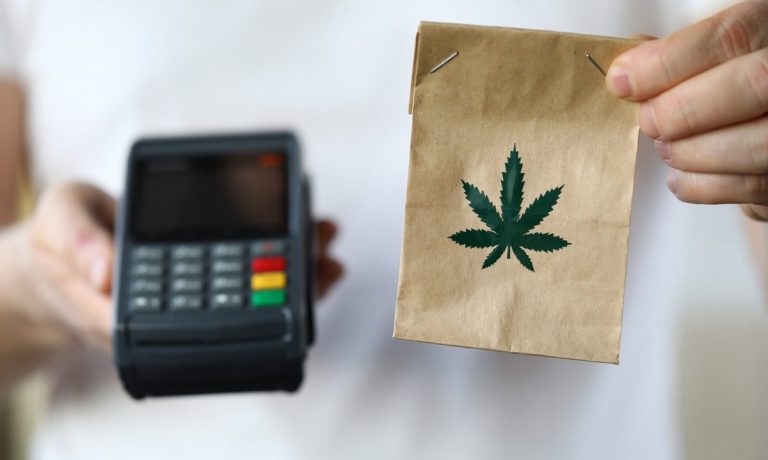
In a curious reversal, the ongoing legalization of cannabis is akin to the repeal of alcohol prohibition of the 1920s, except in that case, the federal government lifted the ban before many states did.
With cannabis, it’s the states that are rolling ahead with medical and recreational use, while the federal government drags its feet. But business is business, and legal cannabis is big business. In the post-pandemic world that means digital payments and delivery are consumer expectations.
To this end, payment platform Aeropay announced in early April that it’s teaming with delivery platform OnFleet for cannabis delivery in the states where that’s allowed — currently, it’s California, Colorado, Massachusetts, Michigan, Nevada and Oregon — although 20 states have legalized recreational cannabis and 20 more have decriminalized it, so delivery isn’t far behind.
Speaking with PYMNTS on the new agreement and industry outlook, Aeropay Chief Revenue Officer Andrew Gleiser said, “When we were looking to determine which partner we should team up with, OnFleet had already made strides. It was a bit of a match made in heaven, two technology platforms that are willing to be open source and focus on what’s right for the industry.”
Aeropay uses bank-to-bank ACH as its core method, an alternative to the cash-based cannabis delivery business that’s sprung up in states where it’s legal. Not only this, but the cashless component has positive impacts on average order values.
“In states like California and other places where delivery is enabled, one of the things that we’ve seen is if you use a cashless payment provider and you have a good last-mile delivery platform, you’re able to remain compliant,” Gleiser said. “What’s most exciting about that is you’re seeing increased cart sizes. For example, before there were cashless payments and good delivery, you had to do everything manually, and cash [on hand] is limited.”
Move that over to cashless delivery, and he said cart sizes tend to be 25% to 35% larger.
“One of the things that I think we’re going to be able to do here is increasing top line revenue up to 35%, if not more, for some of these dispensaries that are enabled for delivery.”
Having come from stints at major payments platforms including Stripe, Gleiser is bemused by the uneven nature of how cannabis is rolling out across America. What stands out to him are many of the inefficiencies that are opportunities waiting for an ignition moment.
“Something that a lot of folks don’t talk about with delivery in the cannabis world is the cost of cash,” he said, adding that “before you had compliant, cashless payment providers and well-integrated, compliant last-mile delivery services, it was a little wild west because you would bring out cannabis to the customers and the drivers would then collect cash.
“It’s not a good idea for obvious reasons.”
Then there’s the notion of fees. Comparing digital cannabis payments to what card networks dealt with decades ago, Gleiser said, “We’re encouraging our providers not to charge a fee, especially when you’re integrated with OnFleet. Make sure that you’re not charging that fee for Aeropay. Why? Because you might charge three bucks, but that might discourage the number of people who are going to have cart sizes 30% bigger on average.”
Illustrating his point, Gleiser said, “We do allow our providers to charge a fee, but you can’t profit off it. And we’ve done studies and found that by charging a fee, you discourage usage. To put some numbers to it, if you don’t charge a fee, we’ve seen adoption anywhere from 10% up to 30%. If you’re charging a fee, it might only be 5% or 10%.”
Pointing to the fragmentation of a cannabis industry that’s inventing itself state by state, awaiting eventual passage of the federal SAFE Banking Act or something like it, Gleiser sees a wave of consolidation not far off, which will make cannabis more akin to the alcohol sector.
“Several of the larger MSOs [multistate operators] have said that this is going to be very much the year of mergers and acquisitions,” he said. “A lot of smaller dispensary groups may be bought by larger ones, and that enables them to scale more in states where you have things like delivery, which tends to be very profitable.”
He thinks that will follow a vertically integrated path where MSOs start behaving more like Walmart or Amazon, using central distribution facilities that save on the cost of retail locations and allow faster delivery to more customers across wider geographical areas.
“Think about pizza,” he said. “If everyone went to go pick up their pizza, they would make a certain amount of money. But the reality is you’re going to make a lot more money as someone that’s offering delivery as well.”
And while nodding to the order-ahead capabilities that many cannabis dispensaries have in place, he’s somewhat astounded by the lack of sophisticated eCommerce for these merchants.
“It’s been interesting to me as someone that’s only been in the space for a short period. I’m like, ‘Wow, you have no eComm yet.’ You’ve got to get on the bandwagon because there’s a reason that Amazon’s one of the biggest companies in the country.”
Here again, Gleiser sees “opportunity in ambiguity to create something new.” For example, he said Aeropay itself is becoming more of a payment method outside of cannabis, with more merchants accepting it for everyday purchases. That positions it well for that moment — probably not far off at this point — when federal law stands down on cannabis.
“What it’s doing right now for us and others that are operating in this space is enabling a micro-evolution, if you will, that I think when SAFE Banking does pass, we’re going to see some interesting things happen, because you’re going to have the traditional big shots of the world, the Visas, the Mastercards [come in], and you’re going to see these other platforms pop up.”